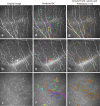Segmentation and Evaluation of Corneal Nerves and Dendritic Cells From In Vivo Confocal Microscopy Images Using Deep Learning
- PMID: 35762938
- PMCID: PMC9251793
- DOI: 10.1167/tvst.11.6.24
Segmentation and Evaluation of Corneal Nerves and Dendritic Cells From In Vivo Confocal Microscopy Images Using Deep Learning
Abstract
Purpose: Segmentation and evaluation of in vivo confocal microscopy (IVCM) images requires manual intervention, which is time consuming, laborious, and non-reproducible. The aim of this research was to develop and validate deep learning-based methods that could automatically segment and evaluate corneal nerve fibers (CNFs) and dendritic cells (DCs) in IVCM images, thereby reducing processing time to analyze larger volumes of clinical images.
Methods: CNF and DC segmentation models were developed based on U-Net and Mask R-CNN architectures, respectively; 10-fold cross-validation was used to evaluate both models. The CNF model was trained and tested using 1097 and 122 images, and the DC model was trained and tested using 679 and 75 images, respectively, at each fold. The CNF morphology, number of nerves, number of branching points, nerve length, and tortuosity were analyzed; for DCs, number, size, and immature-mature cells were analyzed. Python-based software was written for model training, testing, and automatic morphometric parameters evaluation.
Results: The CNF model achieved on average 86.1% sensitivity and 90.1% specificity, and the DC model achieved on average 89.37% precision, 94.43% recall, and 91.83% F1 score. The interclass correlation coefficient (ICC) between manual annotation and automatic segmentation were 0.85, 0.87, 0.95, and 0.88 for CNF number, length, branching points, and tortuosity, respectively, and the ICC for DC number and size were 0.95 and 0.92, respectively.
Conclusions: Our proposed methods demonstrated reliable consistency between manual annotation and automatic segmentation of CNF and DC with rapid speed. The results showed that these approaches have the potential to be implemented into clinical practice in IVCM images.
Translational relevance: The deep learning-based automatic segmentation and quantification algorithm significantly increases the efficiency of evaluating IVCM images, thereby supporting and potentially improving the diagnosis and treatment of ocular surface disease associated with corneal nerves and dendritic cells.
Conflict of interest statement
Disclosure:
Figures










Similar articles
-
A Deep Learning Model for Automated Sub-Basal Corneal Nerve Segmentation and Evaluation Using In Vivo Confocal Microscopy.Transl Vis Sci Technol. 2020 Jun 18;9(2):32. doi: 10.1167/tvst.9.2.32. eCollection 2020 Jun. Transl Vis Sci Technol. 2020. PMID: 32832205 Free PMC article.
-
Generative Adversarial Network Based Automatic Segmentation of Corneal Subbasal Nerves on In Vivo Confocal Microscopy Images.Transl Vis Sci Technol. 2021 May 3;10(6):33. doi: 10.1167/tvst.10.6.33. Transl Vis Sci Technol. 2021. PMID: 34038501 Free PMC article.
-
An artificial intelligence-based deep learning algorithm for the diagnosis of diabetic neuropathy using corneal confocal microscopy: a development and validation study.Diabetologia. 2020 Feb;63(2):419-430. doi: 10.1007/s00125-019-05023-4. Epub 2019 Nov 12. Diabetologia. 2020. PMID: 31720728 Free PMC article.
-
Objective Analysis of Corneal Nerves and Dendritic Cells.Klin Monbl Augenheilkd. 2024 Jun;241(6):713-721. doi: 10.1055/a-2307-0313. Epub 2024 Jun 28. Klin Monbl Augenheilkd. 2024. PMID: 38941998 Review. English, German.
-
In vivo confocal microscopy of human corneal nerves in health, in ocular and systemic disease, and following corneal surgery: a review.Br J Ophthalmol. 2009 Jul;93(7):853-60. doi: 10.1136/bjo.2008.150615. Epub 2008 Nov 19. Br J Ophthalmol. 2009. PMID: 19019923 Review.
Cited by
-
Three-Dimensional Reconstruction of Subbasal Nerve Density in Eyes With Limbal Stem Cell Deficiency: A Pilot Study.Cornea. 2024 Oct 1;43(10):1278-1284. doi: 10.1097/ICO.0000000000003571. Epub 2024 Jun 26. Cornea. 2024. PMID: 38923539
-
Evaluation of a computer-aided diagnostic model for corneal diseases by analyzing in vivo confocal microscopy images.Front Med (Lausanne). 2023 Apr 20;10:1164188. doi: 10.3389/fmed.2023.1164188. eCollection 2023. Front Med (Lausanne). 2023. PMID: 37153082 Free PMC article.
-
In-vivo corneal confocal microscopy: Imaging analysis, biological insights and future directions.Commun Biol. 2023 Jun 19;6(1):652. doi: 10.1038/s42003-023-05005-8. Commun Biol. 2023. PMID: 37336941 Free PMC article. Review.
-
Artificial-Intelligence-Enhanced Analysis of In Vivo Confocal Microscopy in Corneal Diseases: A Review.Diagnostics (Basel). 2024 Mar 26;14(7):694. doi: 10.3390/diagnostics14070694. Diagnostics (Basel). 2024. PMID: 38611606 Free PMC article. Review.
-
AxonFinder: Automated segmentation of tumor innervating neuronal fibers.Heliyon. 2024 Dec 15;11(1):e41209. doi: 10.1016/j.heliyon.2024.e41209. eCollection 2025 Jan 15. Heliyon. 2024. PMID: 39807499 Free PMC article.
References
-
- Craig JP, Nelson JD, Azar DT, et al. .. TFOS DEWS II Report Executive Summary. Ocul Surf. 2017; 15(4): 802–812. - PubMed
-
- Stapleton F, Alves M, Bunya VY, et al. .. TFOS DEWS II Epidemiology Report. Ocul Surf. 2017; 15(3): 334–365. - PubMed
-
- Craig JP, Nichols KK, Akpek EK, et al. .. TFOS DEWS II Definition and Classification Report. Ocul Surf. 2017; 15(3): 276–283. - PubMed
-
- McDonald M, Patel DA, Keith MS, Snedecor SJ.. Economic and humanistic burden of dry eye disease in Europe, North America, and Asia: a systematic literature review. Ocul Surf. 2016; 14(2): 144–167. - PubMed
Publication types
MeSH terms
LinkOut - more resources
Full Text Sources

